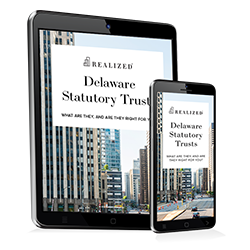
If you’re considering a Delaware Statutory Trust (DST) for your next investment, you’re likely to find that various aspects of it require a deeper understanding to help you feel confident with the commitment. One area you’ll need to be aware of in particular is DST cash distributions — the income you earn from the activity of the underlying properties. While this aspect may seem straightforward, there are several complexities that can be overlooked without proper guidance.
In this article, Realized 1031 provides an in-depth look at DST investment distributions to help you see the full picture.
Basics of DST Distribution
At a surface level, DST distribution is the money the DST sponsor gives to the beneficial interest holders or the investors, as agreed on the private placement memorandum (PPM). This cash is essentially the income you earn from the underlying investment that isn’t property appreciation. How do you receive the funds in the first place?
- Tenants Pay Rent: The real estate assets under the DST earn income from rent paid by the tenants.
- Sponsor Deducts Operating Expenses: These costs include maintenance, property management fees, taxes, and insurance. The leftover amount is the net income.
- Net Income Is Distributed: The amount you receive is based on the beneficial interests you own. Depending on the PPM, sponsors usually distribute income on a monthly or quarterly basis.
DST Cashflow Benefits for Investors
Cash flow is a given based on the DST structure. However, DSTs have inherent characteristics that add additional benefits to the cash flow itself. What are these advantages?
Passive Income
DSTs that qualify for 1031 exchanges must adhere to strict rules, such as the fact that only the sponsor can be in control of the DST’s underlying properties. This means that DSTs are passive investments, so you earn cash without the burden of active management.
Predictable Payouts
While the distributions of DSTs can vary in amount due to broader market conditions, the payout is still predictable. This provides assurance and helps investors with long-term planning for living expenses or reinvestment strategies.
Access to Institutional-grade Assets
DSTs can pool enough funds that allow them to acquire institutional-grade assets. These are properties that are big or productive enough to be eligible for major institutional investors. As you enter the DST, you also access these assets and earn income from their operations, which increases the chances of maximum profits.
Factors That Affect DST Investment Distributions
As mentioned, the amount that you receive can fluctuate. Several factors influence the final cash distribution.
- Property Type: Some sectors tend to perform better in certain economic conditions. Others may face steady growth due to rising demand, fueling income further. There are property types that function instead as a hedge against inflation, reducing the effects of underperforming assets.
- Market Conditions: Local demand, employment trends, and broader economic factors can influence occupancy and rental rates.
- Sponsor Experience: A more experienced sponsor can employ strategies that protect against economic downturns or allow them to acquire profitable properties.
Wrapping Up: DST Cashflow 101 for Investors
Understanding how cash flow works in DSTs helps investors set expectations regarding the investment, especially in the context of long-term income and reinvestments. Plus, this knowledge helps you with sponsor selection, especially when looking at the frequency of distributions, property types, and strategies the sponsor employs to increase potential income.
Sources:
https://www.sciencedirect.com/science/article/pii/S1062940825001287
https://www.irs.gov/pub/irs-drop/rp-20-34.pdf
https://www.nolo.com/legal-encyclopedia/what-is-private-placement-memorandum.html



